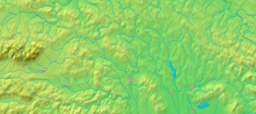Medzilaborce
| Medzilaborce | ||
| Town | ||
|
Medzilaborce main street
|
||
|
|
||
| Name origin: "people amidst the Laborec streams" | ||
| Country | Slovakia | |
|---|---|---|
| Region | Prešov | |
| District | Medzilaborce | |
| River | Laborec | |
| Elevation | 326 m (1,070 ft) | |
| Coordinates | 49°16′15″N 21°54′14″E / 49.27083°N 21.90389°ECoordinates: 49°16′15″N 21°54′14″E / 49.27083°N 21.90389°E | |
| Area | 47.479 km2 (18 sq mi) | |
| Population | 6,616 (31 December 2006) | |
| Density | 139/km2 (360/sq mi) | |
| First mentioned | 1557 | |
| Mayor | Ladislav Demko | |
| Timezone | CET (UTC+1) | |
| - summer (DST) | CEST (UTC+2) | |
| Postal code | 068 01 | |
| Phone prefix | 421-57 | |
| Car plate | ML | |
| Statistics: MOŠ/MIS | ||
| Website: http://www.medzilaborce.net | ||
Medzilaborce (Hungarian: Mezőlaborc, Ukrainian: Меджилабірці, Medzhylabirtsi, Rusyn: Меджильабірці, Medžilabirci) is a town in northeastern Slovakia close to the border with Poland, located near the towns of Sanok and Bukowsko (in southeastern Małopolska). Its population is approximately 6,600.
It is an administrative and cultural centre of the Laborec Region. A train line connects it with the town of Humenné to the south and with Poland to the north. The private sector and service industries are developing quickly in the town at the moment.
It is home to the Andy Warhol Museum of Modern Art, opened in 1991, which contains many artworks and effects of Andy Warhol and of his brother Paul and nephew James Warhola. Warhol's mother, Julia Warhola, was born and lived with her husband in the village of Miková, 17 kilometres (11 miles) to the west.
Medzilaborce is situated in one of the least developed regions of Slovakia. There are three churches in the town.
City parts:
The town of Medzilaborce lies in the valley of the Laborec river in north-eastern Slovakia. The hills of the surrounding Laborec Highlands are typical of this countryside.
The oldest written record connected with Medzilaborce dates back to 1543. The village first belonged to the Drugeth family, but passed to the Csáky family in the 17th century and later in the 19th century to the Andrassy family manor. As early as the 17th century, an important trade route passed through Medzilaborce connecting the interior of Slovakia with Poland through the Lupkov Pass. Medzilaborce became a town in 1860. In 1873, construction of the train track between Humenné and Medzilaborce and further on to Galicia via the Lupkov Pass, which contributed to the growth of the town from 724 inhabitants in 1851 to 1561 citizens in 1910. During World War I, Russian troops entered the town in February 1915 and stayed there until May 1915, leaving the town significantly damaged. During the first Czechoslovak republic, there was massive unemployment, and many people emigrated from the town. The town was significantly damaged again during World War II. It was the seat of the district until 1960, when it was merged with the Humenné district. It has again been the seat of the Medzilaborce district since 1996.
...
Wikipedia






